
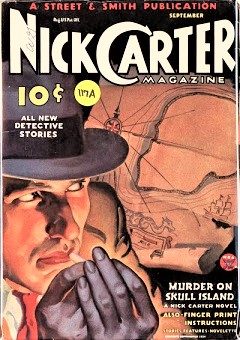 Nick Carter, Master Detective (1943-1955) aired “The Case of the Exploded Alibi” on December 7, 1947. This is only the 12th Nick Carter episode we’ve run since 2009, the last being this past December of 2018. Carter’s history is long, covers numerous media, and is one of the more fascinating we’ve come upon. To crib from one of our earlier entries for new listeners, and slightly tweaked with new material, Nick Carter on radio ran a respectable twelve years, from 1943-1955, but the famous detective’s history begins much earlier. During the post-Civil War era known as Reconstruction, a short story featuring Carter appeared in an obscure fiction paper (The New York Weekly) in 1886 (predating the first Sherlock Holmes story by two years). The publisher was none other than Street & Smith, a fledgling, struggling publishing firm which would later become the most dominant pulp magazine publisher in the world. Among its later titles would be Astounding Science Fiction (now Analog), the only magazine from Street & Smith to survive the pulp magazine crash of the 1950s.
Nick Carter, Master Detective (1943-1955) aired “The Case of the Exploded Alibi” on December 7, 1947. This is only the 12th Nick Carter episode we’ve run since 2009, the last being this past December of 2018. Carter’s history is long, covers numerous media, and is one of the more fascinating we’ve come upon. To crib from one of our earlier entries for new listeners, and slightly tweaked with new material, Nick Carter on radio ran a respectable twelve years, from 1943-1955, but the famous detective’s history begins much earlier. During the post-Civil War era known as Reconstruction, a short story featuring Carter appeared in an obscure fiction paper (The New York Weekly) in 1886 (predating the first Sherlock Holmes story by two years). The publisher was none other than Street & Smith, a fledgling, struggling publishing firm which would later become the most dominant pulp magazine publisher in the world. Among its later titles would be Astounding Science Fiction (now Analog), the only magazine from Street & Smith to survive the pulp magazine crash of the 1950s.
(Top right: Nick Carter, Magazine for September 1934 )
Award-winning radio historian Elizabeth McLeod notes that, “Within a decade, an ongoing series of Nick Carter novels vaulted [Street & Smith] to the front ranks of dime-novel publishers, and made Nick himself a national institution. Nick’s own magazine, The New Nick Carter Weekly, would carry the detective into the twentieth-century.” By 1915, however, the then titled Nick Carter Weekly became Street and Smith’s Detective Story Magazine, a true pulp magazine and S&S’s initial entry into this new format. Again, from Elizabeth McLeod: “Detective Story Weekly soon became Street and Smith’s flagship publication. With the rise of radio in the 1920s, it became the firm’s entree into the broadcast medium. The Street and Smith Detective Story Hour became a favorite of listeners at decade’s end, with elaborate tales of murder and crime hosted by a mysterious narrator introduced only as “The Shadow.” While Nick Carter himself did not appear on the program, his spirit was very much in evidence in the various detective characters that populated the stories.” Of course, we all know what happened next. The mysterious voice only introducing the S&S Detective Story Hour became so popular that S&S launched The Shadow magazine in 1931, and shortly thereafter S&S added Doc Savage to its pulp adventure line. Amidst all of this activity Nick Carter was even given his own magazine (again) in 1933, proving the character’s resiliency and staying power–he was now 47 years old.
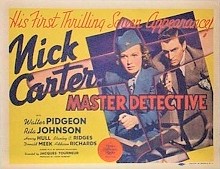
Nick Carter Magazine ran for 40 issues, from March 1933 to June 1936, the final six issues slightly retitled as Nick Carter Detective Magazine. While the magazine had folded, its long-running character still lived, for in 1939 Hollywood picked up the movie rights and produced three “B” Carter films starring noted actor Walter Pidgeon (who later would star in the classic 1956 SF film Forbidden Planet).* A mere three years later, Nick Carter would rise from the dead yet again in his own radio series, Nick Carter, Master Detective. The show’s producer and often the writer, Sherman “Jock” MacGregor, would enlist some of the best writers in the business to script Carter’s episodes, including Robert Arthur and David Kogan of Mysterious Traveler fame, the creator of The Shadow, Walter Gibson, and none other than legendary SF author Alfred Bester (one of which Bester-written episodes, “Chemical Chickens,” we ran in March of 2014 here). Lon Clark played Nick Carter throughout its 12-year run, ably supported by first Helen Choate until mid-1946 and then Charlotte Manson (photo at right with Lon Clark) as Nick’s intelligent, perky secretary Patsy Bowen. Other mainstay characters included Police Sergeant Matty Mathieson, young newspaper reporter Scubby Wilson, and scruffy old veteran of the crime game Waldo McGlynn.
*(The first of the three Nick Carter films was 1939’s Nick Carter, Master Detective. Of interest to genre buffs is that it was directed by Jacques Tourneur, now famous for directing the following trio of Val Lewton horror films: Cat People (1943), I Walked with a Zombie (1943), and The Leopard Man (1943).)
From Nick Carter’s beginnings in 1886 through his final radio show in 1955, Carter would change with the times; from clean-living detective (actually, at the beginning of his career, Nick was a private investigator and consulting detective to the police department, much like Sherlock Holmes, and did not work as a police detective), master of disguise, to anti-espionage agent, to the bane of mad scientists or the defender of scientists beset by crooks, Nick Carter has enjoyed one of the longest surviving, most popular runs in various media for over 100 years, for when his radio show ended in 1955 he would resurface (yet again!) in a series of James Bond-type paperback novels in the 1960s which ran into the 1990s, quite a few of them written by women.
Virtually forgotten today, Nick Carter predates Dashiell Hammett’s Sam Spade, Raymond Chandler’s Philip Marlowe, and was originally inspired by the real-life exploits of private investigator Allan Pinkerton.
“The Case of the Exploded Alibi” finds Nick investigating the murder of a museum security guard and the theft of a rare Egyptian artifact. All clues point to the only possible suspect, but he has an ironclad alibi verified even by the police! How Nick figures this one out is the crux of this fine puzzler, and the only other hint I’ll drop is that it comes from a most unlikely bit of technology.
Play Time: 29:27
{Less than three weeks before Christmas of 1947 found the neighborhood elves at the corner newsstand the day after listening to this episode of Nick Carter, Master Detective and ready for more dangerous sleuthing action. Street & Smith’s Detective Story Magazine (1915-1949) was the first pulp magazine devoted to detective fiction, and coincidentally began in 1915 as a continuation of the Nick Carter Dime Novel series which had folded in the middle of a serial. Detective Story‘s first issue in fact ran the final part of the Nick Carter serial from the magazine’s former incarnation. For approximately the first half of its incredible 34 year run it was a weekly, and it ended having published a whopping 1,000+ issues. It was a monthly in 1947. Detective Tales (1935-53) enjoyed a healthy run of its own with a solid 18 years of mostly monthly issues. In 1947 it, too, was a monthly. Of the magazines below, Dime Detective Magazine (1931-53) chimes in with the second longest run, having survived for 22 years. As with the other two represented below, it was a monthly in 1947. Detective, Crime, and Mystery pulp magazines proliferated from the beginning of the 20th century well into the 1950s, the trio below examples of the relative few enjoying the most loyal audiences over the longest period of time. To place this in a loose perspective, note that since science fiction’s official debut as a genre with the April 1926 issue of Amazing Stories, there are currently only three surviving American professional SF magazines that have lasted more than 20 years: Astounding SF (1930 to present, now Analog), Asimov’s SF (1977 to present), and The Magazine of Fantasy & Science Fiction (1949 to present).]
[Left: S&S Detective Story, Dec. 1947 – Center: Detective Tales, Dec. 1947 – Right: Dime Detective, Dec. 1947]
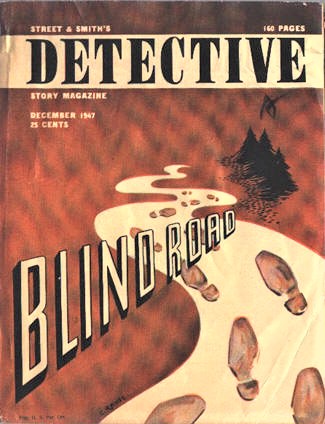
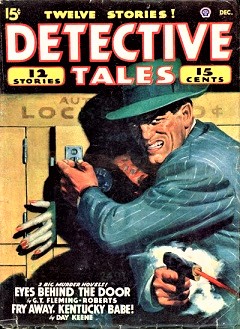
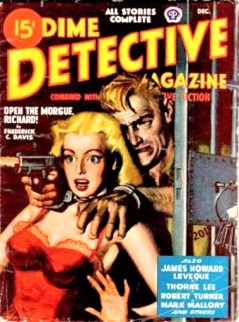
To view the entire list of weekly Old Time Radio episodes at Tangent Online, click here.